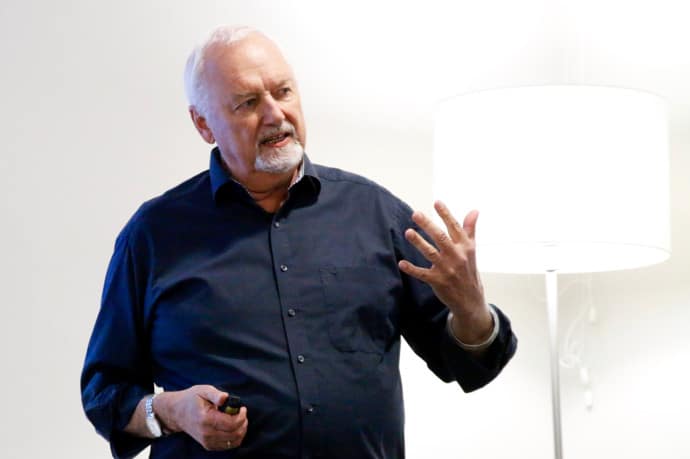“It’s about our children’s children,” said Richard Sikora. “They will live with these problems if we don’t do something now. We have to target the breadbaskets of southern Africa.”

Sikora, who is from the Institute of Crop Science and Resource Conservation at the University of Bonn, is a member of the core group of the STIAS long-term research theme Sustainable Agro-Ecosystems and, along with colleagues Eugene Terry of TransFarm Africa and Paul Vlek of the Centre for Development Research, University of Bonn, gave an update to STIAS fellows on the project The impact of sustainable intensification of agriculture on food production, the environment, and human well-being in the rural urban continuum of southern Africa.
The research programme was organised as a forum or think-tank, in which STIAS fellows and invited international experts came together between 2013 and 2017 to discuss the major elements driving the transformation towards sustainable intensification and food security in Africa. In February 2015 a Roundtable was held, funded by the Marianne and Marcus Wallenberg Foundation, entitled Strategic Directions for Agricultural Transformation in southern Africa. Roundtable participants envisaged agriculture in the region which relies on the region’s natural, human and financial resources to create wealth and jobs, and ensure sustainable food and nutritional security; which allows for innovative farming models at different scales; and, will be competitive and integrated into the regional economy through value chains.
The results of this extensive work will now be consolidated into a book which will hopefully serve as a handbook for practitioners, policy makers and research scientists in the southern African region.
“The multi-author book will outline specific and much-needed strategic building blocks for agricultural transformation that targets policy makers, non-government organisations, agricultural agencies and practitioners responsible for improving food production,” said Sikora. “In the end, we hope it will assist in ensuring food and nutritional security in the region.”
The focus is southern Africa because as Sikora described it “the region is in the eye of the storm. It is characterised by highly degraded soils and is in a very sensitive climatic zone that will be affected severely by climate change which is already seriously impacting food security issues. It’s only going to get warmer and as the soils heat up production of some crops will not be economical – for example, maize will suffer significantly in some parts of South Africa.”
“The current withdrawal of water exceeds the renewable supply in many areas,” he continued. “We are losing water we don’t have now.”
He pointed out that in Africa the population has doubled in 30 years and the urban population has probably tripled. “Yields are not keeping pace with population growth. We would have to increase every crop by at least 1 to 2% per year to feed the growing population,” he added.
He highlighted current constraints in production due to soil degradation, pests and diseases, market factors, population growth, lack of infrastructure and labour amongst other things which are occurring in precisely the areas where intensification is needed.
“In many areas there is a severe lack of proper post-harvest storage of grain and this is leading to major losses in the harvested grain,” continued Sikora. “The storage methods used in many areas are also not sufficient to reduce mycotoxin damage to the harvested grain. In the Aflatoxin-belt Africans are exposed to food with much higher toxin levels than Europeans or Americans living in similar climatic zones. Such toxins are related to increased cancer risk and impede childhood growth and development.”
“Highly damaging pests have been introduced into southern Africa and are threatening food production of important crops across the region. In some cases they will be very difficult to manage without the use of modern technologies. Without extension support their control can lead to improper use of insecticides that can have adverse effects on humans as well as on populations of beneficial insects thereby having a huge impact on crop production.”
“Every technology has the potential for positive and negative effects – it’s up to practitioners within each country to weigh these factors,” he added. “You need the right and appropriate technology in the right place at the right time. In many cases improving production will require improvement in government policy that gives support to the small family farmer and leads to improved food production.”
Challenges of sustainability
In discussion with other STIAS fellows, the group tackled the difficult and multi-dimensional problem of sustainability in agriculture.
“We need to zero in on the areas that have the best chance of sustainability,” said Paul Vlek. “Non-sustainable production is not in anyone’s interest. Sustainability is obviously greatly enhanced if money is created that can be put back into the system.”
“There is currently worldwide debate about whether you invest in more marginal land or in more productive land,” he continued. “Marginal rates of return on investment have diminished on productive land in most of the world, but in Africa these are still high. Governments obviously need to do something for the poorest of the poor farmer but it’s not always the best return on investment.”
“There is also global debate on whether it’s better to support small-scale farmers or larger farms,” added Sikora. “In India and China farms are getting smaller. We need to understand what would be best for Africa. We need to target productive farmers and increase food production.”
“The opportunity for Africa to be sustainable in agriculture is closing rapidly. The war will be won by winning a series of small battles,” said Vlek.
Words: Michelle Galloway, Part-time media officer at STIAS
Photograph: Christoff Pauw
